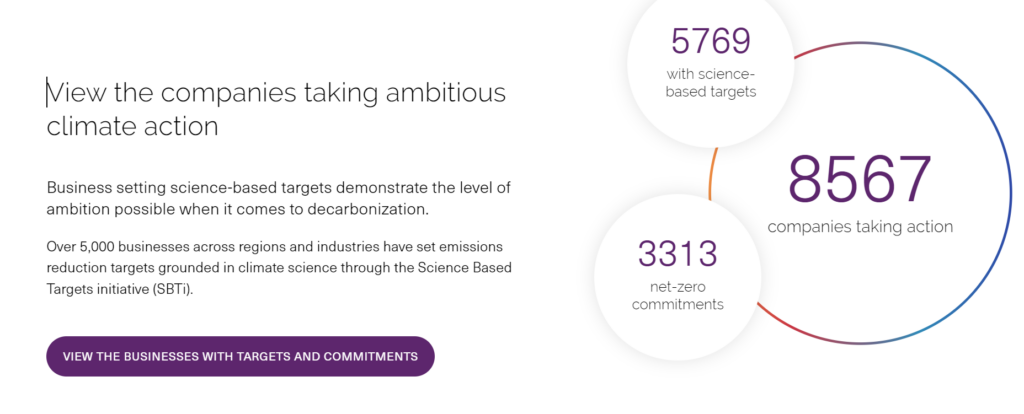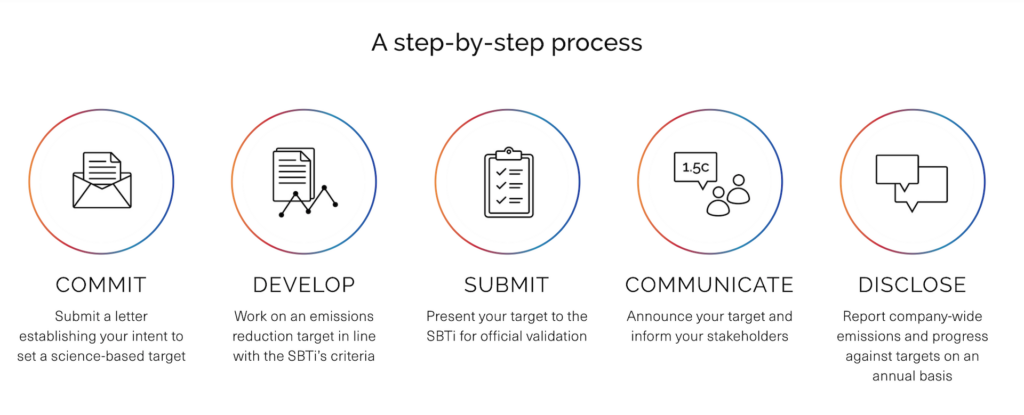Contents
- About the Science Based Targets initiative
- What is a science-based target
- What are the benefits of setting a target?
- Who is setting SBTs?
- How to set an SBT
Share this article
There is a lot of buzz around the phrase ‘science-based targets’, or SBT’s. This article explores who the driving body behind SBT’s is, what are the benefits of setting a science-based target and how to start on the journey to set a science-based target.
About the Science Based Targets initiative (SBTi)
The Science Based Targets initiative (SBTi) drives ambitious climate action in the private sector by enabling companies to set emissions reduction targets based on science. The SBTi is a partnership between CDP, the United Nations Global Compact, World Resources Institute (WRI) and the World Wide Fund for Nature (WWF).
What is a Science-Based Target?
A science-based-target is a target a company sets, to reduce its greenhouse gas (GHG) emissions, in line with emission reduction targets as detailed in the Paris Agreement to keep global temperature increase within 1.5°C and ‘well-bellow 2°C’ compared to pre-industrial temperature levels. This target provides a clearly-defined pathway for companies to take action, to help prevent the worst impacts of climate change and future-proof business growth.
What are the benefits of setting a Science-Based Target?
Good for the planet.
Science-based targets facilitate real emissions reductions that will help accelerate the transition to a low carbon economy and avoid the worst effects of climate change.
Science-based Targets enhance brand reputation and give a competitive edge
Consumers are becoming increasingly aware that the choices they make, have an effect on the environment. Companies who show leadership in reducing the negative impact they have on the planet, such as committing to a science-based target, have an opportunity to enhance their brand reputation and differentiate themselves as leaders. A 2018 YouGov survey of 185 company executives from SBTi committed businesses, showed that 79% of corporate executives found a strengthened brand reputation to be one of the most significant business benefits for their company from committing to the Science Based Targets initiative. This enhanced reputation brings a competitive edge.
Science-based Targets instil investor confidence
Investors are increasingly taking interest in businesses’ environmental policies, as they look to manage investment risk. The Investor Decarbonisation Initiative is a group of more than 60 major investors, who encourage companies to set ambitious climate targets in line with the goals of the Paris Agreement and use the power of the investment system to accelerate corporate climate action.
Science-based Targets offer resilience against regulation
As national governments work towards the Paris agreement goals, companies must expect more and more regulation will be implemented to curb emissions intensive activities and industries.
Science-based Targets increase innovation
With the transition to a low-carbon economy underway and growing in momentum, companies who align their strategies towards setting a science-based target are opening themselves up to new opportunities.
Science-based Targets can lead to cost savings
By setting a science-based target, companies are ensuring their operations remain lean and efficient and are building resilience against a future where resources – particularly those derived from fossil fuels – will become increasingly scarce and expensive.
Source: https://sciencebasedtargets.org/blog/six-business-benefits-of-setting-science-based-targets
Who is setting science-based targets?
SBT’s are becoming more and more popular and there are now nearly 1400 global companies committed to taking action. These include global corporations such as Apple, BMW and Bupa and Australia and New Zealand based businesses such as Intrepid Travel, Bank Australia and Lendlease.

Image: Science Based Targets initiative
How to set a science-based target
Selecting the science-based targets varies in relation to a company’s size, business type and industry. Specific methodologies exist for certain sectors such as Science-Based Targets for Financial Institution’s, Power, Transport and many more. There are plenty of resources available that detail methods, frameworks, tools and guidance, to support businesses in setting robust science-based targets.
The 5 step process

- Commit: Submit a letter establishing your intent to set a science-based target. Once committed, your company has 24 months to complete steps 2-4
- Develop: Work on an emissions reduction target in line with the SBTi’s criteria. An overview of the target development process in the SBTi How-To Guide, followed by reviewing the requirements of target setting in the SBTi Criteria and Recommendations is a great place to start
- Submit: Present your target to the SBTi for official validation
- Communicate: Announce your target and inform your stakeholders
- Disclose: Report company-wide emissions and progress against targets on an annual basis (public)
Learn more at the Science Based Targets initiative and for a more in-depth look on selecting the right SBT approach read our article Selecting the right Science-Based Target.
Science-based targets are a valuable tool for organisations to demonstrate their commitment in the fight against climate change and to keep global warming to below 1.5°C and ‘well-bellow 2°C’ compared to pre-industrial levels. There are a host of benefits that come from setting an SBT and plenty of resources to assist in starting the journey and navigating the process.
Need guidance in setting a science-based target?
We help organisations through the entire process of setting a science-based target. If you’d like to learn more or need help on your journey to set and implement a science-based target, please reach out to our team.


